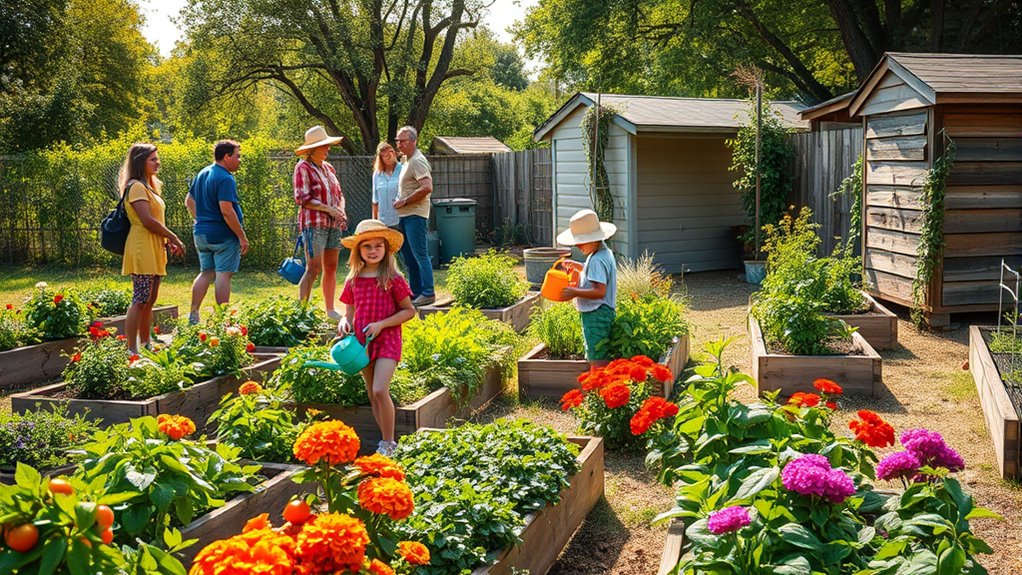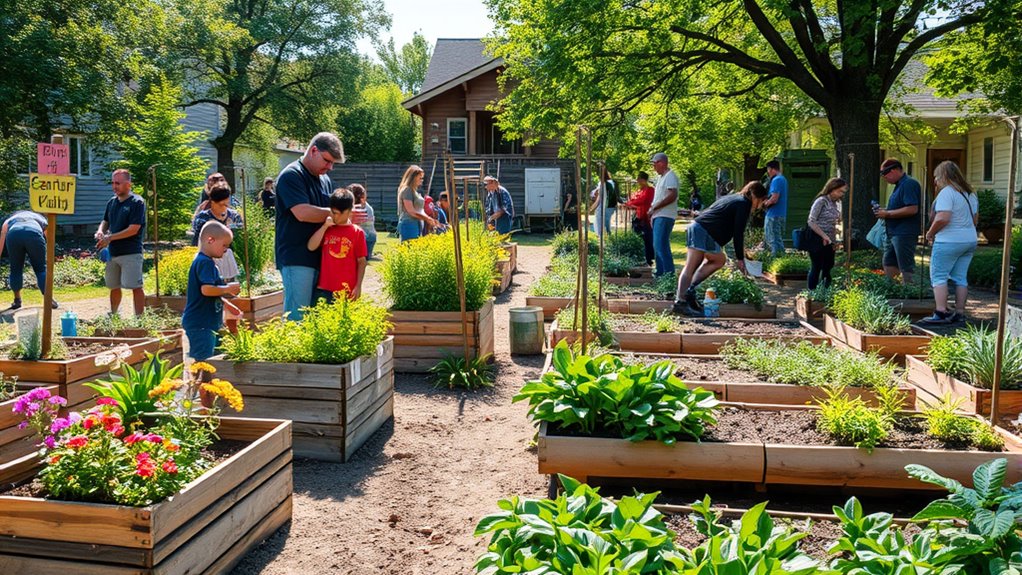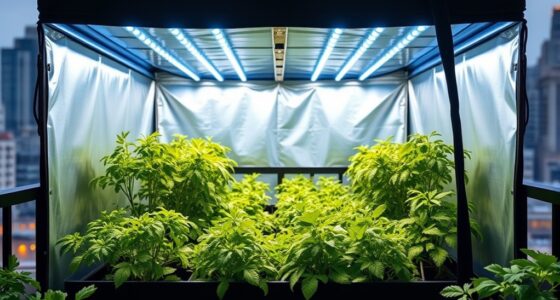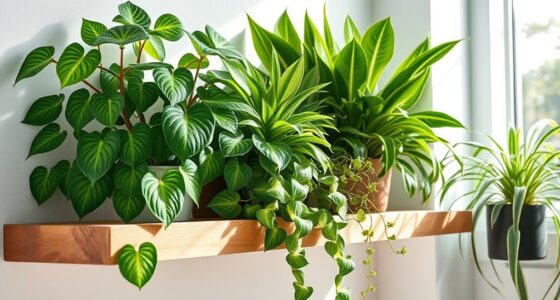Community gardening is a fantastic way to turn vacant lots into lively, green spaces where neighbors can grow food, share resources, and build connections. By composting food scraps and yard waste, you enrich the soil sustainably, while proper tool maintenance keeps your gardening easier and safer. These efforts foster a sense of shared responsibility and environmental pride. Keep exploring to discover simple tips that make your neighborhood garden thrive and become a true community hub.
Key Takeaways
- Community gardens promote urban greening, improve local ecosystems, and enhance neighborhood aesthetics.
- Starting a community garden involves selecting a suitable site, organizing volunteers, and planning plantings.
- Composting food scraps and yard waste enriches soil and reduces landfill waste, supporting sustainable gardening.
- Regular tool maintenance ensures safety, prolongs equipment lifespan, and improves gardening efficiency.
- Engaging residents fosters community bonds, environmental stewardship, and shared responsibility for green spaces.

Have you ever wondered how to turn a small patch of land into a thriving community space? It’s easier than you might think, especially when you focus on key practices like urban composting and proper garden tool maintenance. These steps not only improve the health of your soil but also make gardening more enjoyable and efficient for everyone involved. Urban composting transforms food scraps and yard waste into rich, nutritious soil, reducing waste and providing your community garden with a sustainable source of nutrients. You start by setting up a compost bin in a convenient spot, making sure it’s accessible to all volunteers. Turning your kitchen scraps—like vegetable peelings and coffee grounds—into compost is simple, and it keeps garbage out of landfills. Over time, this compost enriches your garden beds, leading to healthier plants and higher yields. Plus, composting fosters a sense of shared responsibility and environmental stewardship among community members. Utilizing a good free app for tracking your garden’s progress can also help coordinate efforts and share tips among volunteers.
Equally important is maintaining your garden tools. Sharp, clean tools make planting, weeding, and harvesting easier and more effective, ensuring plants grow strong and healthy. Regular garden tool maintenance involves inspecting your tools for rust, dull blades, or loose handles. Keep blades sharp with a sharpening stone or file, and clean off dirt and sap after each use to prevent rust. Oil metal parts periodically to protect against corrosion, and tighten any loose screws or handles. When tools are well-maintained, you’ll notice less fatigue and strain during your gardening sessions, plus your tools will last longer. This attention to detail encourages everyone to take pride in their work, fostering a collaborative environment. Additionally, good tool maintenance reduces the risk of disease transmission between plants, which can happen if contaminated tools are used repeatedly without proper cleaning.
Getting these foundational practices right boosts your chances of creating a successful community garden. Urban composting ensures your soil stays fertile without relying on chemical fertilizers, while diligent garden tool maintenance keeps your gardening efforts smooth and enjoyable. As you involve more neighbors and volunteers, these habits become part of your community’s routine, making the garden a thriving hub of activity and green space. It’s about more than just planting; it’s about building a sustainable, cooperative environment where everyone feels connected. Whether you’re just starting out or looking to improve an existing space, focusing on composting and tool care sets a strong foundation. With a little effort, you can turn that small patch of land into a lush, productive community garden that benefits everyone involved.
Frequently Asked Questions
How Do I Start a Community Gardening Project With No Prior Experience?
To start a community gardening project with no experience, first gather local residents interested in gardening. Decide on a space and plan your garden design, considering sunlight, soil quality, and accessibility. Focus on seed selection by choosing easy-to-grow plants suited for your climate. Reach out to local organizations for advice and resources, and start small to build confidence and community support. Your enthusiasm will inspire others to join!
What Legal Permissions Are Needed to Establish a Community Garden?
To establish a community garden, you need to check local zoning regulations to guarantee your proposed site is permitted for gardening activities. You should also consider obtaining liability insurance to protect yourself and participants from potential accidents. Contact your city or county government for specific permissions or permits, and clarify any restrictions. Taking these steps helps you stay compliant and secure, making your community garden a safe, enjoyable space for everyone.
How Can I Attract More Volunteers to My Community Garden?
Did you know that recognizing volunteers increases participation? To attract more volunteers, focus on volunteer recognition—highlight their efforts on social media outreach, share success stories, and thank contributors publicly. Show appreciation genuinely to foster community pride. Use eye-catching posts and regular updates to keep the momentum going. When people see their impact and feel appreciated, they’re more likely to join and stay committed to your community garden.
What Are the Best Practices for Sustainable and Eco-Friendly Gardening?
You wanna practice sustainable, eco-friendly gardening? Start by using composting techniques to enrich your soil naturally, reducing waste and chemical use. Choose native plant selection to support local ecosystems, attract beneficial insects, and require less water and maintenance. Incorporate rainwater harvesting and organic methods to minimize environmental impact. By adopting these practices, you’ll create a thriving, eco-conscious garden that benefits both your neighborhood and the planet.
How Can Community Gardens Be Used to Promote Local Food Security?
Imagine your neighborhood as a vibrant tapestry, each garden a colorful thread. By embracing urban farming through community gardens, you can grow fresh, local food and strengthen food sovereignty. These green oases provide reliable sources of nutritious produce, reduce dependence on distant suppliers, and empower residents. Together, you transform vacant lots into thriving food hubs, ensuring everyone has access to healthy meals and fostering resilience in your community’s food system.
Conclusion
Now that you’ve learned the basics, it’s time to dig in and start your community garden. Remember, even a small patch can turn your neighborhood into a lush oasis, much like the secret gardens of old. Embrace the teamwork, enjoy the fresh harvest, and watch your community thrive. With a little effort, you’ll make your neighborhood a greener, happier place—no need to wait for a fairy godmother, just your own green thumb!









